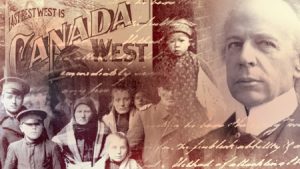
2] In this lesson I say that it should be clear that the discourse on nationalism is also about ethnicity and ideologies of “race.” If you trace the historical overview of nationalism in Canada in the CanLit guide, you will find many examples of state legislation and policies that excluded and discriminated against certain peoples based on ideas about racial inferiority and capacities to assimilate. – and in turn, state legislation and policies that worked to try to rectify early policies of exclusion and racial discrimination. As the guide points out, the nation is an imagined community, whereas the state is a “governed group of people.” For this blog assignment, I would like you to research and summarize one of the state or governing activities, such as The Royal Proclamation 1763, the Indian Act 1876, Immigration Act 1910, or the Multiculturalism Act 1989 – you choose the legislation or policy or commission you find most interesting. Write a blog about your findings and in your conclusion comment on whether or not your findings support Coleman’s argument about the project of white civility.
In answering this question, I will begin to summarize my research findings on the Immigration Act of 1910 and relate these findings to Coleman’s concept of the project of white civility which will illustrate the correlation of Coleman’s argument on the project of white civility and the Immigration Act.
Immigration Act 1910
In my research, I found that the Immigration Act of 1910 was introduced by Clifford Sifton and Sir Wilfrid Laurier (517) who comprised a discriminatory list that aimed to restrict the number of immigrants and justified discriminatory judgments of desirable immigrants/undesirable immigrants (Gagnon et al). In 1907, the increase in the numbers of poor British immigrants coming to Canada who had received social/financial assistance was the leading factor in implementing the Immigration Act in 1910 (Gagnon et al). The list of ‘undesirable immigrants’ consisted of prostitutes, pimps, homeless, mentally ill and criminals (Gagnon et al), while the only desirable immigrants was the agricultural immigrant (518). The government maintained control in the regulation of wanted and unwanted immigrants by not allowing judges and the courts to interfere in the decisions made by the minister (Gagnon et al). For example, the government exercised more control in the process of allowing immigrants overseas than via rail (517), like the requirement of Asian immigrants possessing $250 prior to entry into Canada (Gagnon et al) and the Chinese head tax ranging from $50-$100 (519). Oriental’s were especially discriminated against because their oriental labour was seen as invaluable given that they did not want to settle on the prairies, nor live in Canada permanently (519).
The Project of White Civility
According to Coleman, the project of white civility is derived from the criticism of early literature from colonials and early nation-builders in which the literature elaborates ‘Whiteness’ on the basis of the British model of civility (5). Moreover, Coleman argues that this discriminatory literature in the British model of civility reinforces the privileged status of ‘Whiteness’ in Canada and the concept of the British Whiteness is a form of “fictive ethnicity” that still reinforces the racial divide in the position of power and status in Canada (6-7).
The Link Between The Project of White Civility And The Immigration Act
In regards to my research, I found that the racialized project of white civility argued by Coleman is strongly correlated to Canada’s Immigration Act in 1910. The Immigration Act was a way to create an imagined ‘white’ nation on the basis of discriminatory legislations that prohibited and limited immigration into Canada in 1910. The project of white civility is related to the Immigration Act because the literature is racist in citing the need to limit immigration on the basis of people’s ethnic background which illustrates a way to maintain ‘white power’ by limiting ethnic minorities and justifies the status of British Whiteness in Canada by reinforcing the ‘fictive ethnicity’ through the binary illustration of Asians as undesirables and white agricultural immigrants as desirables (6-7). Moreover, the Immigration Act attempted to mediate and justify the white privilege of the British Whiteness in Canada due to the policy makers (Sifton and Laurier) were in power of a nation that is under the British rule, thus supporting Coleman’s concerns in regards to the English Canadianness represented in the Immigration Act that attempted to construct a national identity that normalized white power in the process of nation-building through the selective process of excluding immigrants of colour as a part of the national Canadian identity, specifically Asian’s (45). The attempted formation of the ‘imagined community’ is also evident in the correlation of the White civility and the Immigration Act because the policy attempts to stay loyal to the racist state authority that justifies Canadian Whiteness by attempting to ethnically cleanse and create a white national identity as expressed in the historical Canadian literature that is influenced by racial ideologies (CanLit Guides).
Works Cited
A_032. 2002. CBC.ca. Canadian Broadcasting Corporation, 2002. Web. 25 June 2016.
Beder, Sharon. “Deserving vs Undeserving Poor.” Herinst.org. Sharon Beder, 2016. Web. 26 June 2016.
Cooper, Luke. “The International Relations Of The ‘Imagined Community’: Explaining The Late Nineteenth-Century Genesis Of The Chinese Nation.” Review Of International Studies 41.3 (2015): 477-501. Historical Abstracts with Full Text. Web. 26 June 2016.
Gagnon, Erica, Jan Raska, Lindsay Van Dyk, Steve Schwinghamer, and Western University. “Immigration Act, 1910.” Pier 21. Canadian Museum of Immigration at Pier 21, 2016. Web. 21 June 2016.
“Introduction to Nationalism.” CanLit Guides. Canadian Literature, n.d. Web. 25 June 2016.
Timlin, Mabel F. “Canada’s Immigration Policy, 1896-1910.” Canadian Journal Of Economics & Political Science 26.4 (1960): 517-532. America: History & Life. Web. 21 June 2016.
Yeager, Matthew G. “Rehabilitating the Criminality of Immigrants under Section 19 of the Canadian Immigration Act.” The International Migration Review 36.1 (2002): 178-92. Web.
